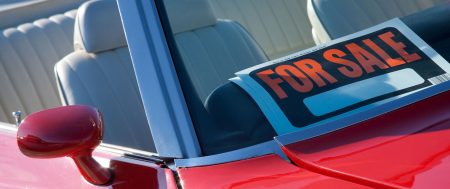Used Car Buying Tips: 10 Steps to a Happy Deal
The following steps will tell you how to locate, price and negotiate to buy the used car you want. If you still don’t know what car to buy, read 10 Steps to Finding the Right Car for You and then come back after you have decided.
Step 1: Getting Started
If you’ve decided to buy a used car, you’ve already made a smart decision. You can get a car that’s almost as good as a brand-new one, without suffering the depreciation that wallops new car buyers as soon as they drive the car off the lot. Used cars – even those that are only one year old – are 20 to 30 percent cheaper than new cars. But there are other good reasons to buy a used car:
- Buying a used car means you can afford a model with more luxury/performance.
- You’ll save money on insurance.
- The glut of cars coming off lease makes finding a near-new vehicle, or “cream puff,” easy.
- Bigger bargains are possible for the smart used car shopper.
- Furthermore, the classic reasons to avoid used cars – lack of reliability and the expense of repairs – are less of an issue. Consider these related thoughts:
- Used cars are more reliable today than ever before.
- Some used cars are still under the factory warranty.
- Most new carmakers now sell certified used cars, which include warranties.
- The history of a used car can easily be traced using the VIN number.
- Financing rates for used cars have dropped in recent years.
- If you buy from a private party, the negotiation process is less stressful.
Step 2: Locate the Right Used Car for You
At the beginning of the car-buying process, many people already have in mind the car they want. But it’s a good idea to stop and ask yourself: Will this car fit into my monthly budget? We’ll explain how to determine what car you can afford in the next step. For now, make sure your choice isn’t obviously exceeding your ability to pay for it. Also, make sure that your used car purchase will meet your current driving needs.
It’s possible that you need to expand your horizons when considering what to buy. You might want to think of other vehicles in the same class. For example, if you are considering a Toyota Camry you should also look at the Honda Accord, Nissan Altima, or Mitsubishi Galant. These cars were built for the same market, but they often have different features at lower prices.
Step 3: Finding Used Car Bargains
The cost of a used car is based on its condition, mileage, reliability, performance and popularity. Of course, you want a car that is reliable and performs well, but do you want the same used car everyone else wants? The more demand there is for a particular make of car, new or used, you will pay a premium for it. In some cases, the only difference is the nameplate, so for the best deal don’t go to the same "fishing hole" as everyone else!
Step 4: Researching Your "New" Used Car
You will find all the information you need to make an informed decision about what to buy on the Edmunds.com used car pages. The major topics are accessed by clicking the links to the left of the screen that list such information as: prices, standard features, specs and safety, warranties, consumer discussions, photos and video and resale values. A helpful feature is "Car Ratings" which includes a bar graph representing consumer satisfaction with this vehicle. You can also read reviews of the car by current owners.
Another essential part of the used car pages is "Price With Options." Edmunds.com has developed a True Market Value (TMV®) pricing system to act as a guideline when car shopping. By clicking a bar labeled "Customized Appraisal" you can price a used car more accurately. This figure is based on thousands of similar sales, nationwide.
One last essential step to getting a great used car deal: run a vehicle history report on any used car you are considering buying. Several companies sell these reports, which are based on the vehicle identification number (VIN), but Carfax (available for all Fred Pilkilton Motors used cars) seems to be the most comprehensive. You will find vital information about the used car including whether or not it has a salvage title (it has been declared a total loss by the insurance company) or evidence to reveal if the odometer has been rolled back. This is also the time to decide if you want a Certified Used Car. If you do, see our story that describes the certified used vehicle programs offered by each manufacturer.
Step 5: How much can you afford?
The smart shopper will consider how to finance the car at the beginning of the shopping process. This will avoid unpleasant surprises later in the game and help you make an unemotional decision that fits your budget.
You will need to estimate three figures that will guide you as you go shopping:
- Monthly payment. If you are going to take out a loan, how much can you afford to pay each month?
- Down payment. How much cash can you put down to reduce your monthly payments?
- Purchase price of the car. Answering the first two questions will help you determine a realistic price range for your used car.
Once you’ve determined how much you can spend for a down payment, a monthly payment and the purchase price of the car, print out these figures. Later, in the heat of the moment, when you are negotiating for a used car, you might need to check the card to bring yourself back to earth.
Step 6: Set up financing for your used car
You have three ways to pay for your used car:
- Cash. Need we say more? Money talks – you-know-what walks.
- Financing through a bank, on-line lender or credit union. We highly recommend this route because it will usually save money and give the consumer the most control over the transaction.
- Financing through the dealer. This can work for some people depending on their credit scores and the current interest rates offered. Also, by prearranging financing through an independent source, the dealer may sometimes offer to beat the rate with a low-interest loan.
- Financing through an independent source (on-line lender, bank or credit union) offers several advantages:
- Keeps negotiations simple in the dealership
- Allows you to shop competitive interest rates ahead of time
- Removes dependency on dealership financing
- Encourages you to stick to your budgeted amount
- Low interest loans can be arranged online through Up2Drive.com
Step 7: Used car markets
The three most common places to buy a used car are:
- Private parties
- New car dealerships
- Used car lots
While private parties may often seem to offer the lowest initial offering price, you won’t have much (or any) information about them – and obviously your recourse if there is a problem can be a big issue. You may feel like you have a more relaxed transaction to buy a used car from a private party rather than to from a car salesman, but don’t mistake an informal relaxed atmosphere with someone who rarely deals in such transactions, with the professional efficiency of a dealer who makes these sales daily. Of course, if that private party is you mom or dad, it’s much more likely that your experience will be the most relaxed (although not always!).
Still, there are advantages to buying a used car from a dealership:
- Dealerships usually get trade-ins at rock-bottom prices.
- If you make a low offer – but one that gives them some profit – you just might get a great deal.
- Furthermore, many dealerships offer certified used cars that have been thoroughly inspected and are backed by attractive warranties.
- CHECK ONLINE REVIEWS – ESPECIALLY GOOGLE+ ‐ Online reviews from actual customers is increasingly becoming the most reliable way to measure a dealer’s performance. Google Plus has become a leader in providing a means for the consumer to rate all types of businesses and provides safeguards to ensure that the reviews are genuine. No one can please everyone all the time, so you’re bound to find a reasonable number of reviews that reflect that there have been issues. Do check for a dealer response to the review. This tells you that they are watching them and that they care about what this means to their business. More than likely, you’ll find that your entire interaction will reflect their desire to get the best possible review in the first place so their only response needs to be ‘thanks’. Also check for how many reviews there are. A dealer who is actively promoting a quality sales experience will have more than just a handful of customer reviews.
Search for your car by using Internet sites such as our Edmunds.com Used Vehicle Listings or the on-line classifieds of your local newspaper. Some sites are very flexible and allow you to search specific criteria such as make, model, options and price range. In some cases you can search the used car inventory of car dealerships through their Web site.
A lot of time can be saved by calling the party selling the car before you go to see the vehicle. In this way, you can eliminate cars that have problems such as excessive mileage or a salvage title. Use Charlton Motor’s Used Car Questions list when calling to help prompt you to ask key questions. Verify the asking price in the ad.
After talking to the seller, set up an appointment for a test drive. If possible, make this appointment during the day so you can more accurately determine the car’s condition. Also, ask for the VIN number so you can run a Carfax report. At the beginning of your used car-buying process you should sign up with Carfax to get its 30 day unlimited car reports service. Every time you get a line on a used car, run the VIN. This will tell you if the car is clean.
Step 8: Test driving a used car
Used car shopping will involve inspecting the vehicle to determine its condition. This process is simplified if you buy a certified used car that has passed a thorough inspection and is backed by a manufacturer’s warranty. But while buying a certified used car removes a lot of the guesswork about the vehicle’s mechanical condition, you pay for this service.
Most new cars are sold with a three-year/36,000-mile warranty. Therefore, if you buy a car that is from one to three years old, with less than 36,000 miles on the odometer, it will still be under the factory warranty. If anything goes wrong with the car you just bought, the problem will be fixed for free. (Warranties vary from one manufacturer to the next. Always read the restrictions of the warranty before buying the car.)
If you are serious about buying a used car but have doubts about its condition, take it to a mechanic you trust. A private party will probably allow you to do this without much resistance. But at a dealership, it might be more difficult. If it is a certified used car, there is no reason to take it to a mechanic.
Once you get behind the wheel, your first impression will be the way the car feels when you sit in it. Is it a good fit? Does it offer enough headroom? Legroom? Are the gauges and controls conveniently positioned?
Try to arrange your test drive so that you start the engine when it is completely cold. Some cars are harder to start when they are dead cold and, when doing so, will reveal chronic problems. Turn off the radio before you begin driving – you want to hear the engine and concentrate on the driving experience.
On the test drive, evaluate these additional points:
- Acceleration from a stop
- Visibility (Check for blind spots)
- Engine noise
- Passing acceleration (Does it downshift quickly and smoothly?)
- Hill-climbing power
- Braking
- Cornering
- Suspension (How does it ride?)
- Rattles and squeaks
- Cargo space
On the test drive, take your time and be sure to simulate the conditions of your normal driving patterns. If you do a lot of highway driving, be sure to go on the highway and take the car up to 65 mph. If you go into the mountains, test the car on a steep slope. You don’t want to find out – after you’ve bought the car – that it doesn’t perform as needed.
After the test drive, ask the owner (if the car’s private owner) if you can see the service records and if receipts are available. If so, note whether the car has had oil changes at regular intervals (at every 5,000 to 7,500 miles). Be cautious of buying a car that has had major repairs such as transmission rebuilds, valve jobs or engine overhauls. If you are uncomfortable doing this, then buying from a private party is of no real value.
Step 9: Negotiating for a used car
Whether you are buying a used car from a dealer or a private party, let them know you have the cash in hand (or financing arranged) to make a deal on the spot. Preface your offer with a statement like, "I’m ready to make a deal now. I can give you cash (or a cashier’s check) now. But we need to talk about the price."
At this point, you need to have a persuasive argument about why the price is too high. So let’s talk about pricing. The foundation of successful negotiation is information. This is particularly true when buying a used car. And yet, the condition of used cars means prices will vary widely.
Edmunds.com has removed much of the guesswork in used car pricing by developing True Market Value pricing. After you have gathered information about a car you are considering, look it up on the Edmunds.com used car pages. When you’re finished, print out the three TMV prices: Trade-In, Private Party and Dealer Retail.
Dealers have lots of experience negotiating. Most private parties do not. Therefore, buying a used car from a dealer or a private party will be two very different experiences. But there is one overriding similarity – they both want to sell the car. In fact, the incentive to sell the car might be greater to the dealer than to the private party owner.
Follow these guidelines when negotiating:
- Only enter into negotiations with a salesperson you feel comfortable with
- Make an opening offer that is low, but in the ballpark
- Decide ahead of time how high you will go and leave when your limit’s reached
- Walk out – this is your strongest negotiating tool
- Be patient – plan to spend an hour or more negotiating
- Leave the dealership if you get tired or hungry
- Don’t be distracted by pitches for related items such as extended warranties or anti-theft devices
- Expect a "closer" (another salesman you’ve haven’t previously dealt with) to try to improve the deal before you reach a final price
Once you have a deal, you need to make sure the transaction is completed properly. The next section, which is the final step, will tell you what to expect and what you need to do.
Step 10: Closing the deal
- If you are at a dealership, you still have to go through the finance and insurance process. If you are buying a car from a private party, you have to make sure that payment is made and the title and registration are properly transferred.
- In both cases, you also need to make sure you have insurance for the car you just bought before you drive it away. Also, the finance and insurance person will probably try to sell you a number of additional items: an extended warranty, alarms or anti-theft services such as LoJack, prepaid service plans, fabric protection, rust proofing and emergency roadside kits. Some people swear by extended warranties, so this is something you might want to consider (unless your used car is certified or still under the manufacturer’s warranty).
- The finance and insurance person may seem like a financial advisor, but he or she is really an experienced salesperson. Some finance and insurance people can become very persistent trying to sell these items. Be firm, explaining that you just want the car, if you have these covered elsewhere.
- Once the contract is ready, review it thoroughly. In most states, it will contain the cost of the vehicle, a documentation fee, a smog fee, a small charge for a smog certificate, sales tax and license fees (also known as DMV fees). Make sure you understand the charges and question the appearance of any significant, sudden additions to the contract.
- Finally, you should inspect the car before you take possession of it. If any repair work is required, and has been promised by the dealer, get it in writing in a “Due Bill.” Make sure the temporary registration has been put in the proper place and – you’re finally on your way.
- When you buy a car from a private party, you will probably be asked to pay with a cashier’s check or in cash. But before money changes hands, request the title (sometimes called the “pink slip”) and have it signed over to you. Rules governing vehicle registration and licensing vary from state to state. Check with the DMV in your state (much of this information is now available on DMV Web sites).
- Once all of the paperwork is complete, it is finally time to relax and begin enjoying your new purchase: a good used car.




